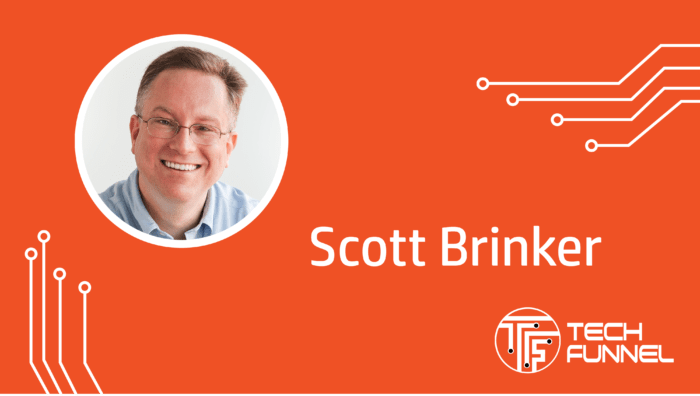Welcome to TechFunnel.com’s interview with Scott Brinker. In this interview, he shares his journey from game development to being a CEO at the young age of 21, writing software to diving into marketing, to launching ion interactive and why he views marketing as both an art and a science.
Scott Brinker is a software product leader, currently serving as VP Platform Ecosystem at HubSpot, where he directs the company’s platform strategy and leads business programs for its technology partner ecosystem. Before that, he was the co-founder and CTO of ion interactive, a SaaS company that pioneered interactive content for global enterprises (Cisco, Dell, DHL, General Mills, Microsoft, etc.) and was acquired by ScribbleLive in 2017.
Since 2008, he has also run the Chief Marketing Technologist blog, chiefmartec.com, with over 40,000 readers, analyzing topics at the intersection of marketing, technology, and management. He created the Marketing Technology Landscape, charting the growth of the marketing technology industry from a few hundred vendors to over 5,000. In 2014, he launched the MarTech conference, where he serves as the event’s program chair.
He is the author of “Hacking Marketing,” published by Wiley in 2016, and co-author of the article “The Rise of the Chief Marketing Technologist” published in Harvard Business Review in 2014. He is a frequent keynote speaker at conferences around the world on topics of marketing technology and agile marketing.
Hosting the interview is Jonathan Rosenfeld, Bython Media’s Director of Demand Generation. Jonathan focuses on business development and client relationships. He’s an accomplished digital marketing professional with over 14 years of experience. Utilizing a consultative approach, he’s helped major companies like Citrix, American Honda, and Universal Music Group achieve their marketing goals.
***
JR: I did some research into your background and it is really fascinating your origins in the working world – starting GalactiComm at such an early age, being 15, and then eventually becoming the Vice President of the company and then the CEO at the age of 21. I’m really interested in learning what caught your interest in BBS and game development at such a young age and how do you feel GalactiComm shaped your experience as an entrepreneur and a marketer?
SB: I got into BBS as a user – this was before the internet and the web took off. There were all new dial up services – probably the most popular one that everyone has heard of is America Online. But even before that, there were these independent dial up BBS systems and as a kid watching the movie “War Games” just set up an “Oh! You have this modem for your computer, and you can dial up the system – isn’t that cool!” So, as a young teenager I thought that was the coolest thing. I started using BBS and got interested in the software that ran it, started writing my own (software), started creating multi-player games and just fell into entrepreneurial work as a software developer as a game creator at the time.
JR: Very cool! So, you just found a way to tie your career into your passion and realized “Hey, I can make a career out of this?” just based on how the technology was evolving in the early 90s?
SB: Yes. And I think there was a shift where I went from just writing the software to really getting involved in marketing of it, helping to promote it and win more business, until I eventually ended up working on the marketing side of GalactiComm. That was really fascinating to me because a lot of the early adopters of BBS in the business world were also marketing organizations, using it (BBS) to connect with clients in different industries and engage with them, and so marketing to marketers with technology in the early 90s – “Wow! This is cool!”. I had no idea it would grow to be what it eventually did become.
JR: I really feel that most people, when they were kids, didn’t necessarily feel like “One day I want to help businesses sell products.” We often fall into marketing as a result of doing something else that we’re passionate about and it seems like that might be the case with you as well. You started with development, and then realized you had to take these games to market and figure out a way to monetize them. It’s really interesting – the transition, for you as well, coming from the development side and then to the marketing side, and then eventually having a C-level position within the organization at such a young age.
SB: Yes, that was unusual! (Chuckles)
JR: That is basically why I wanted to touch on it – there aren’t many 20-year-old CEOs in the world, right? You definitely might have been a 1 of 1 at that time period.
SB: I think that’s the key. That time period was certainly unique but it’s funny – in the past decade or two with the internet I feel there’s been so many breakout CEOs, young CEOs stories. I mean, Mark Zuckerberg, right? He is the poster boy for that. It doesn’t feel like it is that much of a claim to fame any more, but back in the day it was a little bit novel.
JR: For sure! I can’t imagine there was a whole lot in 1993 when you became the CEO. That most have been a unique situation at that point. Just going ahead to the transition from GalactiComm – Once you left that company, you then founded Ion Interactive with Chris Robert and Justin and Anna Talerico. One of Ion’s products Liveball was a widely used landing page tool, and I’m really interested in what was the inspiration you had in terms of leveraging the framework of Liveball to create that Landing Page 2.0 or “Interactive Content” that became the current form of Ion.
SB: For the first part of Ion’s life, we were essentially a boutique web development agency. So, we weren’t technically like a software company with a product – we were a web development shop. We would get hired by marketing teams of really large companies. Citrix was one of our big clients there. One of the things that early on was happening there was that Citrix and other clients, they had their website. But anytime a large corporation wanted to change their website, it was like an enormous process requiring all these approvals and sign offs, planning and budgeting and a lot of marketing. There were things that wanted run on the internet –and they couldn’t wait for one, two or three months. It would be like getting a page and run a search marketing or email campaign or something like that, and so that was when we started doing some of that work custom for Citrix. We realized that we had a fair number of marketers that we’d run into that would really love to have a lightweight web publishing for multi-step landing pages. That became the seed for the product that would eventually grow into the Ion platform. We launched that in 2007 and really shifted the company from being a primarily services business into primarily a software business.
JR: I really appreciate the clarity there. When I first reached out to you, I mentioned that I gift ‘Hacking Marketing’ to new members of our team here and I mentioned how it does a great job of framing what the current marketing landscape looks like. What are some books that you recommend to new members of your team at HubSpot or people that you’re associated with that are looking to pursue marketing in this day and age.
SB: It’s interesting – some of my favourite books aren’t technically marketing books. I think they capture the dynamic of what’s happening in today’s world. 2 of my favourite ones are a book called “Anti fragile” by Nassim Nicholas Taleb. It is really about change- you can start thinking about creating things in a way that change doesn’t harm it. Change actually makes it stronger. It’s a day when business and technology is changing at such an incredible rate, I find a lot of the concepts in that book to be incredibly germane to what we’re all wrestling with. The other book fascinating me these days is “Platform Revolution”, written by a group of authors – Geoffrey G. Parker, Marshall W. Van Alstyne and Sangeet Paul Choudary. It’s all about platform businesses – not just software platforms but market platforms like Uber and Airbnb, and so many other dynamics of platforms are now relevant to pretty much every business to a certain degree. I find that a really fascinating study of just one of the factors that go into the platform dynamics.
JR: Speaking of platforms, I took a look at one of your post in January about a second golden age of MarTech and one key aspect that stuck out to me was the concept of platform ecosystems being a part of this new gilded age of MarTech. The overall concept reminded me a lot of what HubSpot’s current positioning is as a platform as a service. Your role at HubSpot – was this concept of platform as a service something you spearheaded, or something that you saw that trends were headed in the direction of Martech and so the organization pivoted towards that direction to basically provide more value and differentiate from competitors?
SB: I think this was always one of the visions of the founders Brian Halligan and Dharmesh Shah had. They always envisioned HubSpot becoming a true platform company someday, but companies go through stages of growth and maturity – they start with one product and then expand it to a suite. As they started to gain more momentum, they became a public company, had tens of thousands of customers and started to reach a scale where becoming a true platform made sense, since they had a lot of value to offer in this ecosystem to other people who wanted to participate. So, I joined them to help with that transition and it’s been an absolutely fascinating journey. I feel very privileged to have the opportunity to help them with that mission.
JR: So it seems this is something that was always on the roadmap and they basically found somebody who’s aligned with that vision with yourself, to help them implement the process.
SB: Yes.
JR: Awesome. One thing conceptually I thought would resonate with you a little bit – I was at MeritDirect Marketing Exchange last week, and I attended a keynote from Ron Tite – he’s an author of a book called “Everyone is an Artist”. I felt like this concept would resonate with you as well, as I saw that you have a bit of a musical background as well. You were a Music major initially – do you feel like having a creative outlet, such as music for example, can make you a better marketer and positively impact your work in a lot of different ways?
SB: Certainly. I think creativity in whatever channel you can find, in whatever channel inspires you is the key to differentiate, particularly in a world where we’ve got more and more algorithms, machine learning and artificial intelligence, the raw analytical horsepower can all be done by machines, but when it comes to that creative spark, that is something that is still a uniquely human quality. So whether it is music or writing or art – even programming in some way becomes an art. Whatever vehicle inspires you, I definitely think that helps.
JR: Right. I’ve always viewed marketing as a combination of art and science – you really have to tap into both the left and right sides of your brain to be ultimately successful in this sort of a role. So it seems that you have that same sensibility as well. I just want to end up here with one last question related to the MarTech West Conference, with it starting on April 3rd – just interested in some of the differences that are going to take place in this year’s version of the event that attendees should expect.
SB: I am very excited for this event. Can’t believe it’s only a couple of weeks away. Some of the things I am particularly excited about is we’ve got a couple of sessions keynotes around Direct to Consumer brands, so Terence Kawaja – the CEO OF Luma Partners, the guy who actually started all these landscapes, Marun Gupta – who’s one of the pioneers in marketing technology and the CMO of Freshly – they’re all going to be going into how D2C brands in many ways are built on martech. These are native martech powered companies. Some of the other folks I am super interested in the martech head from Etna, woman running martceh at the New York Times, CMO of NPR talking abot how they’re incorporating the voice systems and voice commerce into their mission, Head of Analytics from Nordstrom, lot of people who run the experimentation program at Netflix. I think there can be a lot of really amazing people sharing what they are doing, not hypothetically, but in the real world – leveraging martech for their success.
JR: That’s fantastic, and I think that’s ultimately why people get such great value form attending the event. I haven’t talked to somebody that left with a bad taste in their mouth from attending MarTech. There are definitely action items that you can take from it, and it seems like it really runs the gamut from B2C to B2B, all different types of applications of the technology and best practices on how to use it. It’s great to see that it is continuing to grow. Thank you for taking the time to speak with me. I really appreciate it.





